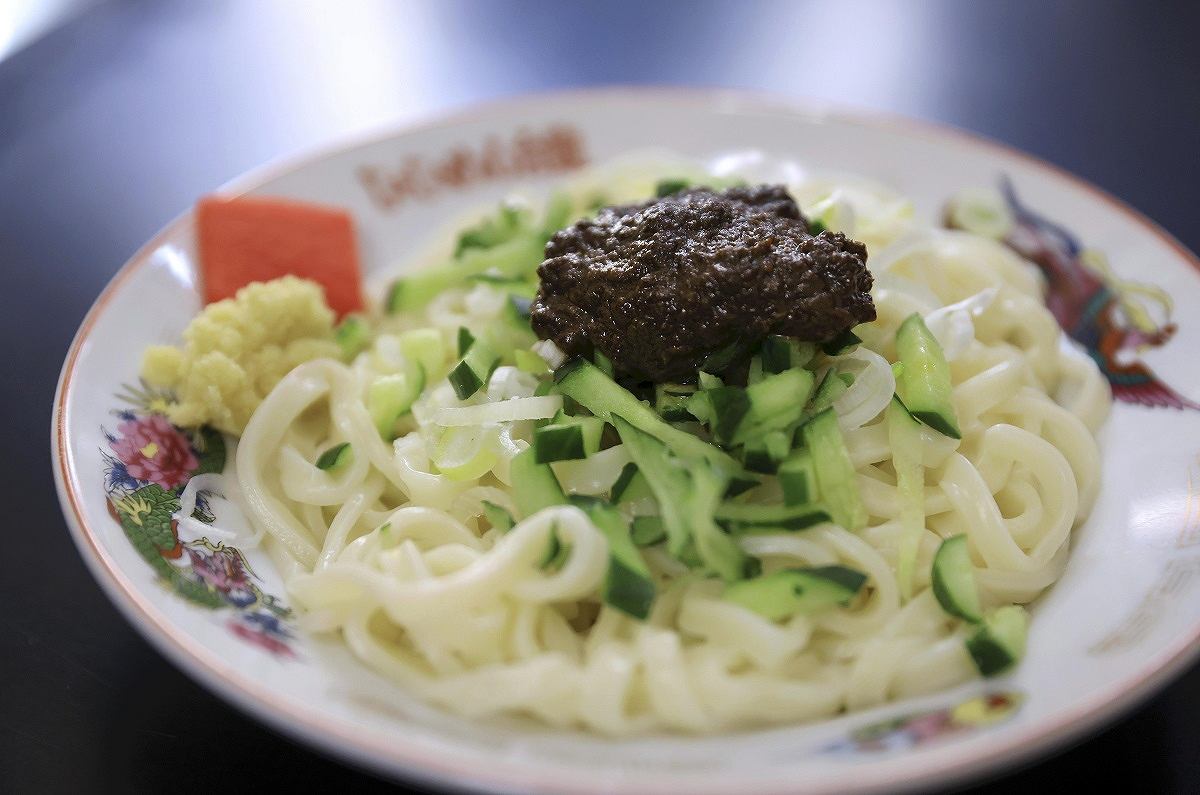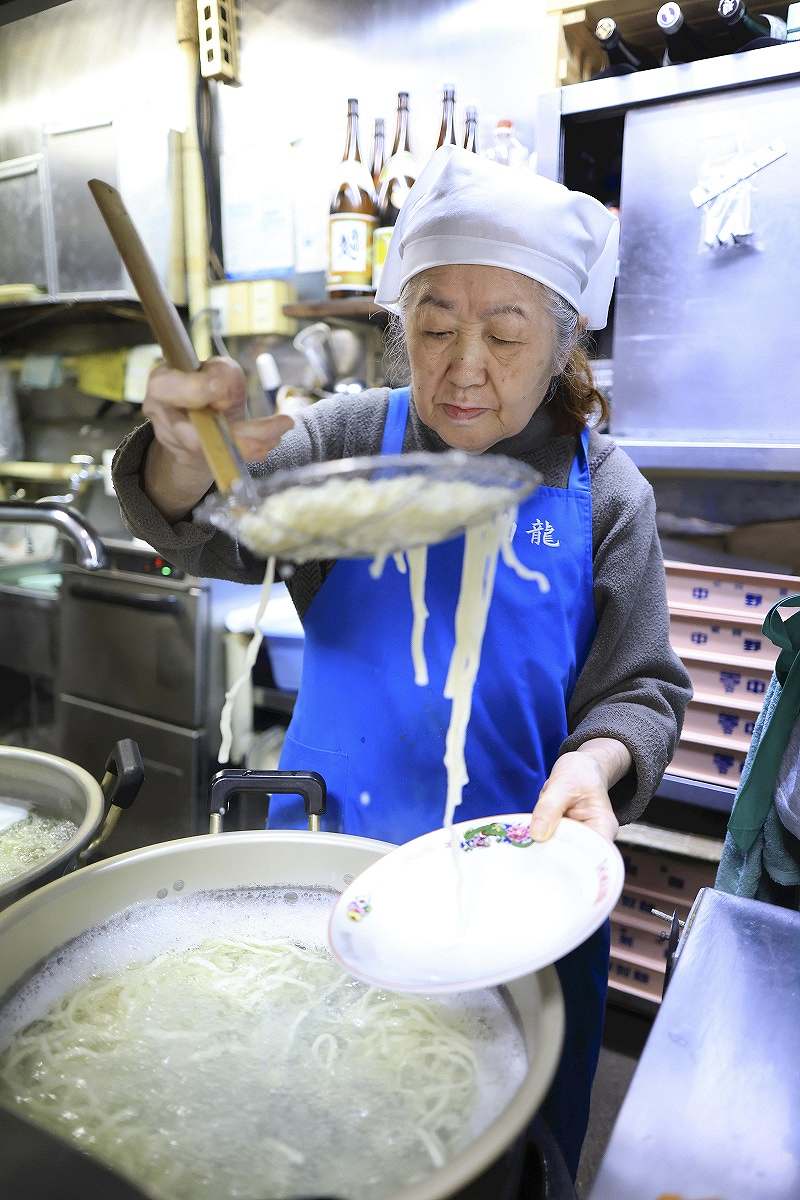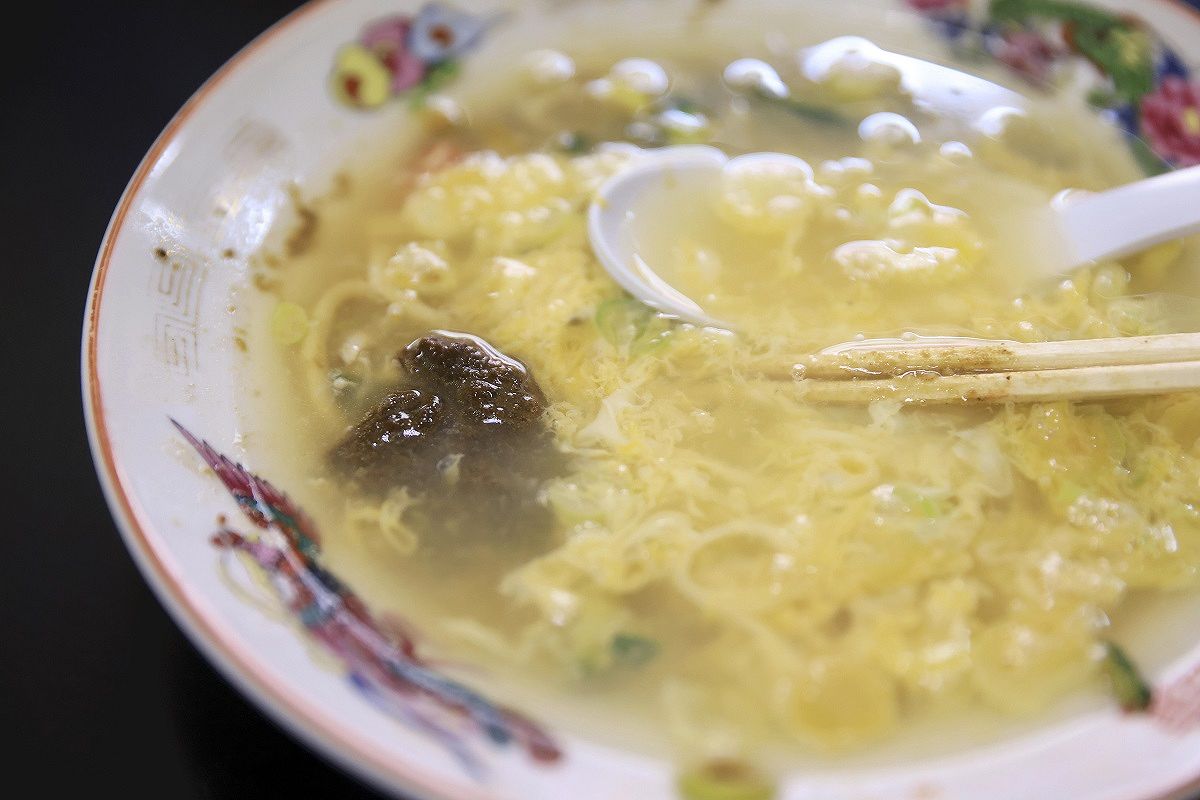
Pairon’s jaja-men noodle dish.
10:30 JST, November 5, 2023
MORIOKA — A long line of customers wait outside a “jaja-men” noodle restaurant in the city of Morioka, named one of the 52 places to go in 2023 by the New York Times in January.
Pairon can be found in a corner of the Sakurayama district, with its narrow wooden storefront that still retains the atmosphere of the Showa era (1926-89) in a city frequented by foreign tourists.
At first glance, one might walk right past it, but I managed to find it after spotting the long line that appears at lunchtime.
As I pushed aside the noren curtain with the name “Pairon” written on it and walked through the door, the scent of salty miso tickled my nostrils. A wall inside the restaurant, covered in autographed cards from celebrities, is a sign of its popularity.
A 57-year-old man from Ireland sat at the counter eating jaja-men, the restaurant’s signature dish. He visited Pairon after reading about it in a travel guide.
Mineko Takashina, 81, who runs the restaurant, peeked out from the kitchen to ask if the food was to his liking. He replied in English that the taste was different from what he had imagined. But the surprise was nice, he added, and gave her a thumbs up.
“Ever since the article appeared in the paper, we have had a lot of foreign customers. I speak to them in Japanese, but everyone is so nice,” she said.

A European tourist eats jaja-men at Pairon.
Special miso sauce
I used to eat Chinese “zha jiang mian” when I was a student, but I had no idea what jaja-men was like.
One look and the difference was obvious. The dish does not use Chinese noodles, but instead uses flat noodles that were developed in cooperation with a noodle factory in the city. The dark miso meat sauce, which takes about an hour to prepare every morning, is made by mixing ground meat, shiitake mushrooms, garlic and other ingredients with Sendai red miso soybean paste.
The dish is best eaten by mixing the rich miso meat sauce with the noodles.
At first, I was surprised to find that the noodles were soft and chewy. With their sticky texture, they resemble neither udon nor kishimen noodles, but are very satisfying.
Takashina offered various condiments one after another, and passed them over the counter, saying, “Mix the condiments of your choice with the noodles.” They included vinegar, grated ginger juice and chili peppers pickled in soy sauce.
I couldn’t stop eating the noodles as I ate them with seasonings that I liked. The amount of noodles come in three sizes: small, medium and large, ranging from ¥560 to ¥760. Even the small size was enough to fill my stomach.
Jaja-men traces its roots to Manchuria, now northeastern China, where Takashina was born. Takashina’s family returned to Japan ahead of her father, Kansho, who left Manchuria to join them in 1953. After his return, he started serving the noodle dish at a food stall in an attempt to reproduce the authentic Chinese zha jiang mian noodles. In the 1970s, he opened the main restaurant at the current location.
Her father, a quiet man with a craftsman’s attitude, never taught her how to make the miso sauce. However, when he was in a good mood, he would say, “Miso is the key,” and laugh, Takashina reminisced.
Because of his extreme fastidiousness to the dish’s taste, he once threw a jar of miso on the floor when a customer, also a repatriate, told him, “[Zha jiang mian] doesn’t taste like this.”
Relying on memories
Takashina, who always watched her father closely, began helping out at the restaurant after graduating from culinary school. She married and had two sons, but her husband died in 1980.
In 1991, her father collapsed in the kitchen one morning while preparing food and died suddenly.
At first, Takashina had no intention of taking over the restaurant and wanted to become a pastry chef. Her mother, Teru, took over the restaurant after her husband’s death, but there was no successor to her mother, and there was no recipe for the secret miso meat sauce.
But then Takashina thought of her mother, who had also lost a husband, and didn’t want to cause her to have a hard time. So, she decided to make the miso meat sauce with her mother from memory.
Certain customers who knew the taste from when her father made the sauce said it used to be a little sweeter, but Takashina believed in her own way and continued making it. She thought, “No matter what they say, I will continue to do it my way. By doing so, we will be able to attract customers.”
She was afraid to ask some other regular customers what they thought, but customers encouraged Takashina and her mother, saying the taste was just as it had always been.
In the 2000s, jaja-men became known as one of the three most popular noodles in Morioka, along with reimen cold noodles and wanko soba noodles.
After her mother died in 2002, Takashina became the third owner and works at the restaurant with her second son, Katsuo, 49.
Pairon now has three restaurants in the city, and the taste of Takashina’s miso meat sauce is firmly rooted among the local people. With her eye on creating a flavor loved around the world, Takashina continues to stand in front of a big pot in the kitchen.

Mineko Takashina drains hot water from noodles at Pairon in Morioka.
Enjoying the last dish
Another way to enjoy jaja-men is to eat “chi tan tang” or egg drop soup, as the last dish of one’s meal.
Crack an egg onto the noodles and beat well with chopsticks. Add miso meat sauce and green onions, then pour the noodle broth over the ingredients.
The first bite does not have that strong of a taste. But the miso sauce that accumulates at the bottom of the bowl gradually mixes with the broth, and the soup becomes thicker and thicker.
Takashina’s father, Kansho, was a heavy drinker and used to have egg soup in the mornings when he had a hangover. The soup was added to the menu as chi tan tang at the suggestion of a regular customer, Takashina said.
Chi tan tang, which can be ordered for an additional ¥50, is a popular dish among after-work snack bar proprietresses.

Chi tan tang egg drop soup
"Features" POPULAR ARTICLE
-

Sanrio to Open Museum in Yamanashi Pref. Dedicated to Founder, Exhibits Include Hello Kitty, Other Characters
-

Autumn Foliage Surrounds Visitors to Tokyo’s Showa Kinen Park
-

My Daughter No Longer Speaks to Me, But I Want to See Her and My Grandchild
-

Kumamoto: Public Bath Refurbished as Library Where You Can Chat, Take Photos
-

Frozen Vegetables: Demand Rises for Convenient, Tasty Domestic Produce
JN ACCESS RANKING
-

Keidanren Chairman Yoshinobu Tsutsui Visits Kashiwazaki-Kariwa Nuclear Power Plant; Inspects New Emergency Safety System
-

Imports of Rare Earths from China Facing Delays, May Be Caused by Deterioration of Japan-China Relations
-

University of Tokyo Professor Discusses Japanese Economic Security in Interview Ahead of Forum
-

Japan Pulls out of Vietnam Nuclear Project, Complicating Hanoi’s Power Plans
-

Govt Aims to Expand NISA Program Lineup, Abolish Age Restriction






















